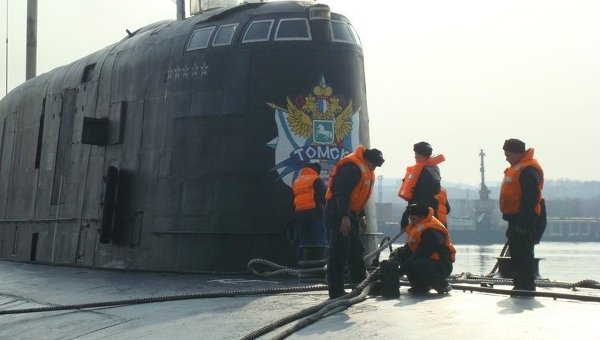
Russian Navy Cannot Escape Its Sinking Feeling
Publication: Eurasia Daily Monitor Volume: 10 Issue: 169
By:

Moscow’s recent high profile diplomatic involvement in the Syria crisis resulted, in part, in some unmerited publicity for its navy due to the decision to dispatch a number of its assets to the Mediterranean Sea. The juxtaposition of the Russian Navy vis-à-vis the naval fleet of its former Cold War adversary needs no serious response. But what is much more revealing, in terms of the sharp chasm between the rhetoric of the Russian political-military leadership and Russia’s existing limited military capabilities, is the ongoing tragi-comic condition of the submarine fleet (RIA Novosti, September 18). This situation, known to the leadership even prior to the Kursk submarine tragedy in 2000, relates to work safety standards and the poor condition of domestic shipyards. As long as these situations reoccur, with little progress to remedy underlying issues, the Kremlin’s claims to great power status will resonate only with the most fervent nationalists.
The “virtual reality show” that now marks Russia’s conventional Armed Forces, following several years of reform efforts under the mismanagement of the disgraced former Defense Minister Anatoly Serdyukov, was most recently underscored by the chief of the General Staff (CGS), Army-General Valery Gerasimov. The CGS noted that since the reform began in 2008, with only 10 percent of Russian weapons and equipment inventory then considered as modern or “new,” the figure now stands at “17 percent,” with a target of “19 percent” by the end of the year. While the aim of reaching “70 percent” new or modern by 2020 increasingly appears ridiculous, Gerasimov went much further into the realm of fantasy. Following several years of repeated claims that the “New Look” Armed Forces were fully manned, and permanently ready, the CGS admitted that by the end of 2013, the military will reach its “planned level” of only “82 percent” manning; evidently failure in Moscow can also mean success (Interfax, September 16).
This surreal context frames the decision by President Vladimir Putin to order another so-called “snap inspection” to coincide with the bilateral Russia-Belarus Zapad (West) 2013 military exercises (September 20–26), this time concentrating on the interior ministry and other civilian agencies. Such “surprise” inspections serve negligible value. Putin chose to announce this latest “snap inspection” during a video conference with the defense ministry and other power ministry heads. Meanwhile, the Russian president was briefed by Defense Minister, Army-General Sergei Shoigu on the fire-fighting operation on the Tomsk submarine, which erupted while in dry dock (kremlin.ru, September 16).
The fire on the Tomsk K-150 Project 949A nuclear powered submarine broke out at 4:30 a.m., local time, on September 16, while undergoing repairs in the Russian Far East. It seems the fire resulted from “safety violations” during welding work. Nine teams from the Pacific Fleet’s 703rd base, as well as four emergency ministry fire-fighting units participated in the ensuing operation. Shoigu told his commander-in-chief that the accident demonstrated the need for “stricter control” at the shipyard and over how this type of work is handled in the future. Nonetheless, the minister appeared to be ambivalent about the small detail concerning the submarine in question having been in dry dock for repair since 2009 (kremlin.ru, September 16).
The facts concerning the submarine fire are indeed both embarrassing and revealing for the section of the Russian security elite concerned with military capability. On the early morning of September 16, smoke was reported over the submarine in the Zvezda shipyard; the stench of burnt rubber was also detected in the nearby city of Bolshoy Kamen. A subsequent statement issued by the United Shipbuilding Corporation stated that the “rubber insulation and old paint within the main ballast tanks of the Tomsk” had “caught fire during welding operations. This caused smoke to flood the space between the two submarine hulls; there were no injuries.” “The only danger is the high-pressure ballast tanks located between the pressurized inner hull and the outer hull. If they are full, they will explode when heated,” said Yuriy Karetnikov, a former submariner and retired colonel. “There can be no explosion since the submarine was in ‘dry dock repair’ conditions. There is nothing to worry about,” argued Gennadiy Khvatov, a retired vice admiral and former commander of the Pacific Fleet (Rossiyskaya Gazeta, September 17).
Of course, this is by no means a rare incident for the Russian Navy, since the last fire that broke out during a routine repair for a submarine occurred on December 29, 2011; the K-84 Ekaterinburg nuclear powered ballistic-missile submarine was in also in dry dock for repair, and the fire that took place during that accident lasted for nine hours. The Ekaterinburg was part of the sea deployment of the Northern Fleet Russian Strategic Nuclear Forces. The backbone of these forces is made up of the five submarines under the 667BDRM design developed by the Rubin Central Design Bureau for Marine Engineering in St. Petersburg (the submarines are the Bryansk, Verkhoturye, Karelia, Novomoskovsk and Tula). Such accidents are evidently not rare in the experience of the Russian Navy (Rossiyskaya Gazeta, September 17).
The condition of the submarine element of the Russian Navy, by no means the only issue confronting the force structure, comes at a time when the political elite wanted to highlight the “deployment” of a small number of surface naval vessels to the Mediterranean in the context of the Syria crisis. Underlying this “deployment” is the ongoing systemic weakness of the Russian Navy, with its aging assets, under funding, and a host of problems that serve to limit the impact of the “show” in such movements (Nezavisimoye Voyennoye Obozreniye, September 17).
Weakness of Russia’s Navy is nothing new, but the links between the crisis in the Middle East, the claims of the Russian political-military leadership concerning the bright future for the military, and the comments by Gerasimov about “82-percent” manning are all worth noting. Failure can be regarded by these officials as success, but the regime simply cannot convince its foreign or domestic audiences that all is well within these Armed Forces structures. So long as the emphasis continues to be on show and not on laying down steel, reforming the defense industry and revamping shipyards, the condition of the Russian Navy will languish in its rusting and decaying morass.




